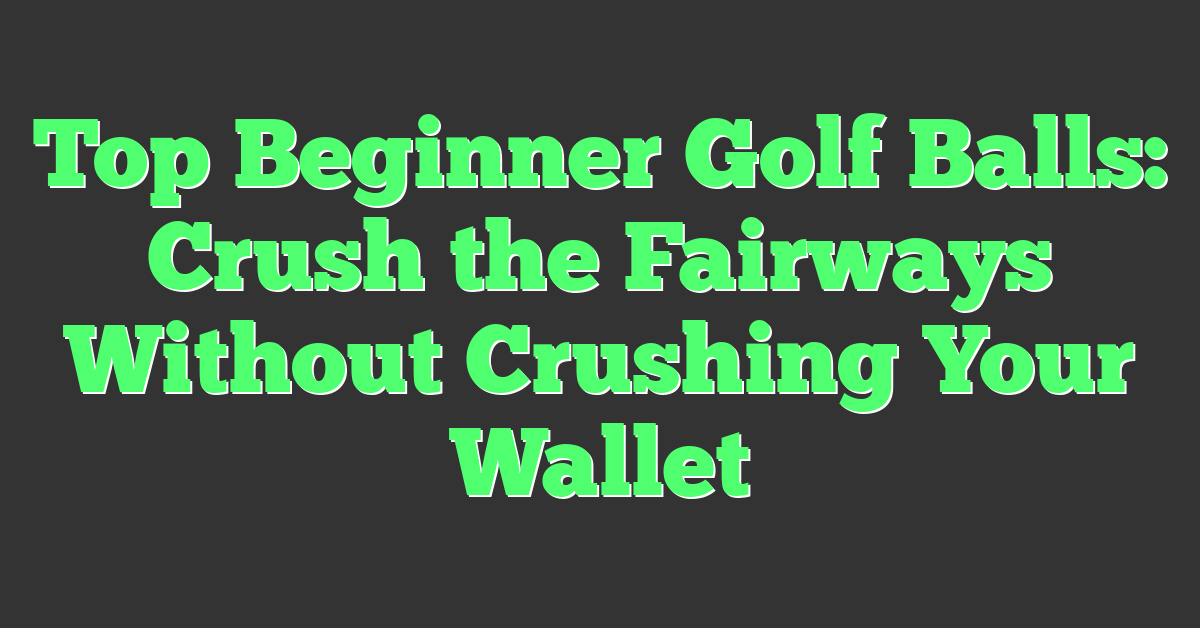Starting your golf journey can feel like you’re stepping onto a whole new planet, with gear choices as vast as the greens you’re aiming for. But don’t sweat it; finding the right golf ball is a lot simpler than mastering your swing. As a beginner, you’re looking for a ball that forgives your rookie mistakes and maybe, just maybe, makes you look a bit more like a pro.

Choosing the perfect golf ball is about matching it to your current skills and the goals you’ve set for yourself. Whether you’re focused on distance, control, or just keeping it out of the water hazards, there’s a golf ball that fits your beginner status and won’t break the bank. Let’s tee up and dive into what makes a golf ball a beginner’s best friend on the course.
Understanding the importance of choosing the right golf ball
As someone who’s played their whole life, you’ll hear me often say that the right equipment can define your game. In the case of golf balls, it’s about understanding how they react to each swing you take. You want a ball that complements your skill level and, more importantly, one that forgives the little mistakes that are inevitable as you’re learning the ropes.
Construction is the key here. Golf balls can be two-piece, multi-layered, and so on. As a beginner, you’re better off with a two-piece ball that provides more distance and durability. These balls typically have a solid core and a durable cover which helps to minimize spin – thus reducing the likelihood that you’ll end up sending your shot veering wildly off course.
Another factor you’ll want to consider is feel. A softer ball can give you better control, particularly around the greens where finesse matters more than power. You might think soft balls are just for pros, but in reality, they can help you as your touch and control around the greens develop.
Lastly, don’t overlook the importance of visibility. You may not think it’s a big deal, but a high-visibility ball not only saves time searching for it but can also help in aligning your shots better as you can see the spin and roll after your shots.
Think of choosing a golf ball as pairing the right wine with your meal – the better the match, the more enjoyable the experience. This selection process is unique to you, as everyone has different strengths, preferences, and aspects of their game they want to enhance. Remember, the goal is to help you shoot lower scores and enjoy the game more – so take the time to test different balls and see how they resonate with your playing style.
Key considerations for beginner golfers
As someone diving into the world of golf, there are critical factors you’ll want to consider when selecting your first set of golf balls. It’s more than just picking a brand you recognize; selection criteria should be tailored to your developmental needs.
Firstly, compression is a term that you’ll hear often. It refers to how much a golf ball deforms at impact. Balls with low compression are typically softer, making them preferable if your swing speed isn’t quite up there with the pros. They can help you achieve better distance from slower swings—an essential component for your burgeoning game.
Then, there’s the matter of spin. Beginners might overlook this, but spin can significantly influence your ball’s flight and landing. High-spin balls tend to veer more dramatically with hooks or slices, which isn’t ideal if you’re still working on your accuracy. Rather, aim for balls designed for low to mid-spin to help keep your shots straighter.
Don’t forget about the ball’s feel. When you’re around the greens, a ball that provides a softer feel is invaluable. It gives you better feedback and control for those critical short-game shots. A hard ball might bounce too much or roll out further than you intended, complicating your efforts to lower your scores.
Lastly, always consider durability. As a beginner, you’re likely to lose a few balls to water hazards or the rough. It’s a rite of passage, so there’s no need to splurge on the high-end tour balls just yet. Look for something that withstands the occasional scrape against the cart path or bounce off a tree.
By keeping these factors in mind, you’re already on the path to becoming a more knowledgeable and skillful golfer. Remember, the right golf ball is a small, yet mighty ally on your journey to shooting lower scores.
Finding the right balance of distance and control
When you’re out on the golf course, balancing distance with control is like finding the perfect rhythm in a dance—it’s essential for a great performance. Your golf ball plays a starring role in this dance. It’s not just about smashing the ball off the tee; it’s about placing it where you want it, shot after shot.
Distance is tempting; it feels good to see the ball fly far. But without control, it’s like a sports car without brakes: exciting but potentially disastrous. You need a ball that’ll go the distance, sure, but you also want it to obey your commands when approaching the green. A two-piece golf ball can offer you the best of both worlds. It’s designed to give you those extra yards off the tee and still allow for ample control when you need finesse.
Think of control as your ball’s ability to respond to intentional variations in your swing. This might mean softer landing on greens or reliable spin when you’re aiming for precision. Control is about predictability, and for a beginner, predictability is key to building confidence and skill.
It’s wise to experiment with different golf balls to see how they react to your style of play. Pay attention to:
- How the ball feels off the clubface
- The trajectory of your shots
- The spin you’re getting—especially around the greens
- How the ball rolls on the putting surface
Remember, no single ball will make you a pro overnight. But the right one can help enhance your natural abilities and compensate for beginner inconsistencies. Balance comes with practice, but it starts with choosing the right equipment. As you develop your game, you’re likely to find your preferences shifting—possibly towards a multi-layer ball that offers more spin or a firmer feel. It’s all part of the golf journey.
Don’t rush the process; give yourself time to learn how different balls impact your game. After all, every swing you take is an opportunity to understand more about your play style and what works best for you on the course.
The role of compression in golf ball selection
When you’re out on the course, looking to shave strokes off your game, the term “compression” might come up. Compression refers to the hardness of a golf ball, or how much it flattens when it’s hit. It’s crucial for you to know how this impacts your game.

Misses feel harsher with a high-compression ball. It’s designed for players who have a faster swing speed, as the ball won’t compress as much upon impact, resulting in greater distance. But as a beginner, you’re likely still working on your swing speed. A low-compression ball, which is softer, would be more beneficial for your game. It compresses more easily, aiding in achieving more distance even with a slower swing.
Table of Golf Ball Compression Ratings:
| Compression Rating | Swing Speed | Ball Type |
|---|---|---|
| High (>100) | Fast (>105 mph) | High-compression |
| Medium (85-100) | Average (85-105 mph) | Medium-compression |
| Low (<85) | Slow (<85 mph) | Low-compression |
Experiment with different compressions to find what suits you. If you’re not sure about your swing speed, attending a fitting session with a professional could help you determine it, along with the best ball for your game.
Remember, the goal is to have a ball that optimizes your performance. If the ball’s too hard for your swing speed, it won’t compress properly, leading to a loss of energy transfer and, subsequently, distance and control. On the other hand, a ball that’s too soft may feel great on impact but could lead to reduced control and precision, especially in windy conditions.
Your golf ball should help you gain distance without sacrificing feel and control around the green. Notice how the ball feels on impact, how it behaves on short shots, and its trajectory and roll. Low-compression balls can offer beginners significant benefits as they learn and develop their swing.

As you grow in the game, your equipment will evolve with you. Ball selection is a dynamic process that should shift as your skills improve and your speed increases. Keep tabs on how your playing preferences change over time—it’s all part of your journey to becoming a better golfer.
Budget-friendly options for beginner golfers
When you’re just starting out in golf, you’re probably not keen on breaking the bank for equipment. Luckily, the market has plenty of budget-friendly golf balls that are perfect for beginners.
Value packs and discount brands won’t dent your wallet as much as premium balls, and they serve your game just as well while you’re learning the ropes. These balls are designed to deliver a decent performance without the high cost, and for your stage in the learning curve, they’re often the smart choice.
Here are a few options that won’t leave you feeling guilty if they end up in the water hazard:
- Wilson Ultra Golf Balls: These balls are known for a good distance and durable construction.
- Pinnacle Soft Golf Balls: Offering a soft feel, they are aimed at improving your game without the premium price tag.
- Callaway Supersoft Golf Balls: While slightly higher in price, they combine a lower compression with a soft cover for better control.
These brands often offer their balls in larger quantities, which can save you even more in the long run. Prices vary, but generally, you can find these options in the range of $15 to $25 per dozen.

| Brand | Price Range (per dozen) |
|---|---|
| Wilson Ultra | $15 – $20 |
| Pinnacle Soft | $15 – $20 |
| Callaway Supersoft | $20 – $25 |
Remember, it’s fine to try out several different types to see what you like best – there’s no one-size-fits-all in golf. Focus on finding balls that aid your learning process and feel good off the club. As you progress, you might develop a preference for balls that enhance specific aspects of your play, like control or distance.
Don’t worry if seasoned players suggest more expensive balls. Your priority right now should be on getting a feel for the game and improving your swing. As long as the balls you choose help you to achieve those goals, you’re on the right track. Keep practicing, and you’ll notice how a ball’s performance changes as your skills grow more refined.
Conclusion
You’ve got the scoop on some great golf ball options to start your journey on the greens. Remember, the best ball for you is one that feels right and helps you hone your skills. Don’t sweat the fancy stuff just yet—focus on enjoying the game and watching your swing improve. And who knows? As you get better, you’ll find that perfect golf ball that seems like it’s made just for you. But for now, grab a sleeve of those beginner-friendly balls and hit the course with confidence. Happy golfing!










